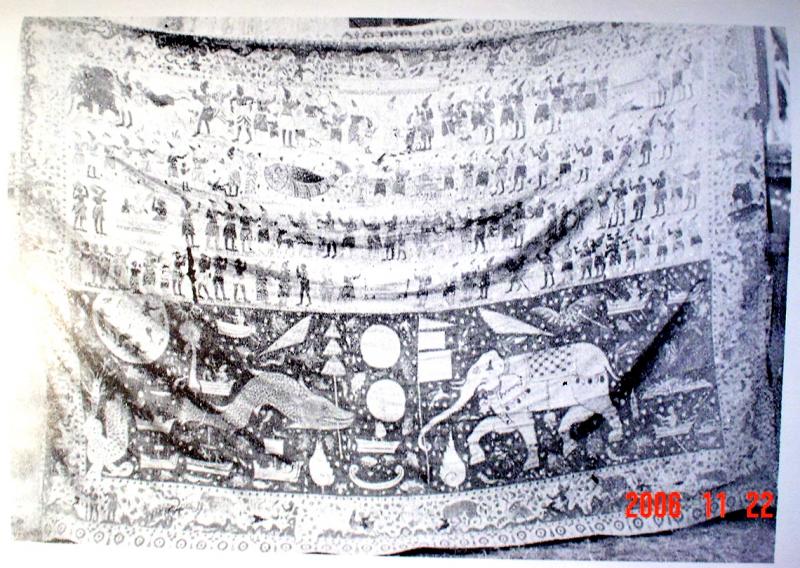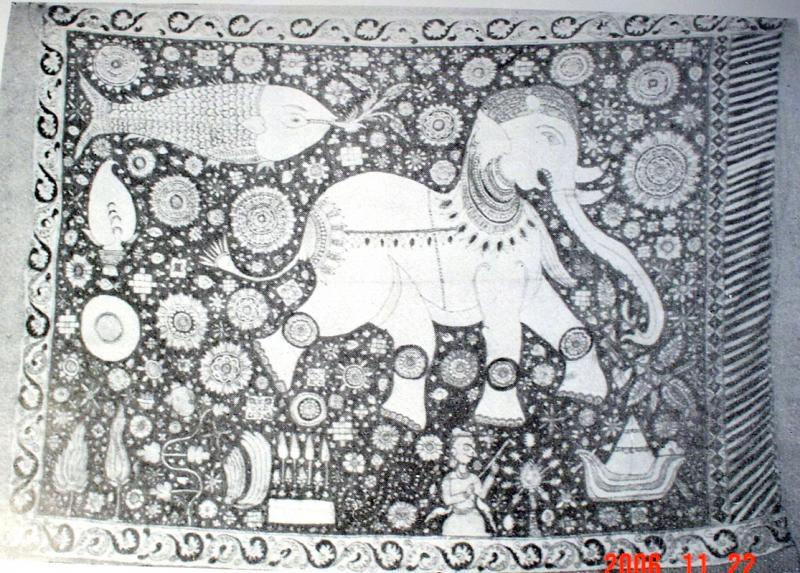Karava of Sri Lanka
Royal symbols of Sri lanka
The Sun and Moon symbols
The Sun and the Moon symbols were the recurrent royal symbols used continuously by Sri Lankan monarchs. They represented the claim by Sri Lankan monarchs that they descended from the Indian Solar and Lunar dynasties.
As dynasties and ruling families changed, the Elephant, Ship and Fish symbols too were used by Sri Lankan royal families intermittently, along with the Sun and Moon symbols of royalty.
However contrary to popular modern belief, the Lion was not the perpetual royal symbol of Sri Lanka. The lion symbol was mainly promoted by the Indian born medieval Kalinga kings of Polonnaruwa and the Karava Singhe Dynasty of Jaffna. The modern Lion symbol myths were created by political upstarts to introduce divisive politics to Sri Lanka as their vehicle to political power.
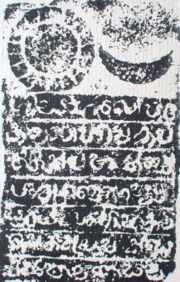
Left: An ancient Sri lankan inscription with the Sun & Moon symbols denoting the king's race Surya / Chandra wamsa
Contrary to the modern belief, the Kings and Queens of Anuradhapura and Polonnaruwa did not claim to be Sinhalese. However, they have consistently claimed in their inscriptions to be from the Kshatriya race and Indian Sun Dynasty (Surya wamsa) and Lunar Dynasty (Chandra Kula). The ancient Mahavamsa chronicle of Sri Lanka too refers to them in the same way.
Accordingly the royal symbols of such monarchs were the Sun and the Moon. The Lion was not a royal symbol for these monarchs and they used the lion image on foot-stones at entrances to buildings and on urinal-stones. The lion appears to have been an important symbol only for the Indian born Kalinga kings of Sri Lanka, mainly Nissankamalla (1187-1196 ), who claimed to hail from Sinhapura (lion city).
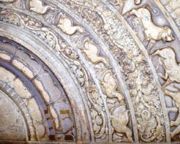
Left : The Lion image as used on ancient foot-stones in Anuradhapura. The Lion was not a 'royal symbol' or a 'dynastic emblem' for ancient Sri Lankan kings or queens. They were all Kshatriyas who claimed descent from Indian Solar and Lunar Dynasties and their royal symbols were the Sun and the Moon. These monarchs used the lion image on foot-stones at entrances to buildings and on urinal-stones
The Sun and Moon figure throughout Sri Lankan history and these two symbols are found on medieval gold coins and inscriptions. Some modern historians have attempted to down play their re-interpret these symbols and say that they indicate perpetuity rather than the solar and lunar descent of the monarchs.
The Sun symbol is displayed prominently on the tomb of Prince Don Joan of Kandy and on the throne and also the palace walls of the last king of Kandy Sri Wikrama Rajasinghe.
The Sun and Moon symbols are recurrent symbols on the flags of the Karave caste. See Karava Heraldry.
The Sun and Moon flag is one of the main flags of the Karavas. The Mukkara Hatana (palm leaf manuscript now in the British museum) and royal sannas (grants) describe that King Parakramabahu VI allowed the Karavas to continue using this flag in Sri Lanka.
The Fish & Ship symbols
The Fish and Ship symbols appear to have been the dynastic symbols of several ancient Sri lankan ruling clans.
Many Pre-christian Brahmi rock inscriptions scattered across Sri Lanka right into the deep south, particularly the inscriptions caused to be engraved by Baratas, bear the symbol of a ship.
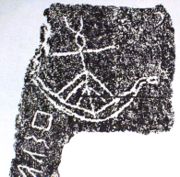
Right: A section of a pre-christian Brahmi inscription from Kottademuhela, Sri Lanka showing an example of the fish symbol used by the Kataragama Kshatriyas as their dynastic symbol.
In addition, the pre-christian rock inscriptions of the Kataragama Kshatriyas always carry the Fish symbol. According to Paranavitana: " ...the fish symbol is found in all the inscriptions at Kotedemuhela as well as Bowategala, where members of the Kshatriya family of Kataragama find mention. The Fish appears therefore to have been the dynastic symbol of these princes" (Paranavitana 1970 pg LIX)
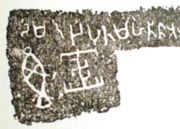
Right: A section of a pre-christian Brahmi inscription from Kottademuhela, Sri Lanka showing an example of the fish symbol used by the Kataragama Kshatriyas as their dynastic symbol.
These Kataragama Kshatriya kings describe themselves in their pre-christian inscriptions as " Gamini puta dasa kathikana Kedhate ..." (Bovattegala inscription, Early Inscriptions of Ceylon part I p 41 # 549).
Kedhate was the early form of Kevatta meaning 'mastery over water'. Over a thousand years later, when Kevatta also meant a fisherman, chroniclers have used prefixes to distinguish Dunu-kevatta vamsa warrior royalty (Ariyapala p 113) from Vedi-kevatta tribal fishermen.
The word Dheega meaning water is frequently used by these kings in their personal names such as Dheegha-Gamini, Dheega-Jantu etc. and in place names such as Dhiga-Vapi, Dhiga-Mandala etc. The word Kataragama too in its original form was Kachara (Ka +Chara) where Ka meant water and Chara meant 'travelling on', meaning sailing and naval power. (Yatala Vehera p 19)
Recent excavations in the south have also unearthed many types of pre-christian period coins with the Fish symbol. Of particular interest are the coins with 2 fish and the legend 'Barata Tisa' in ancient Brahmi characters and another with an elephant and the legend 'Majjima' (Illustrations A12 and A5 Bopearachchi pgs 52 & 53). Barata is the original royal house of The Kauavas and the Pandavas and the inscription on the Council terrace at Anuradhapura shows the link in Sri Lanka.
The continuity of this Barata link upto the Kotte period is shown by the Padakada copper plate inscription of King Parakramabahu VI in which the king refers to himself as hailing from the Barata kula (JRASCB XXXVI). Majjima was a name used by Sri Lankan kings (Paranavithana 1970 pg LXXVIII inscription 406) and is preserved in Karava ancestral names such as Madduma Patabendige.
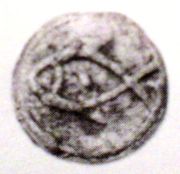
A pre-Christian coin from southern Sri lanka showing an example of the use of the fish symbol as a dynastic symbol.
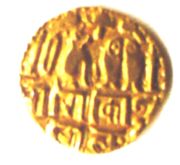
The fish symbol is also found on mediaeval coins of Sri Lanka . The coin illustrated on the right is a gold coin of Gangai Konda Chola displaying his royal insignia: A royal parasol, Tiger and two fish.
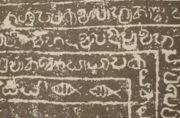
Kings Parakramabahu the Great and Nissankamalla are two Sri Lankan kings to have extensively used the Fish symbol on their inscriptions.
Above: A part of a 12th century stone inscription showing an example of the use of the fish symbol as a royal symbol in the Polonnaruwa kingdom of Sri Lanka
The Fish symbol and the Ship symbol are also recurrent symbols on Karava Heraldry
Below: The tombstone of Patangatim Francisco Piris’ wife from St. Thomas Church, Jinthupitiya illustrated here, shows that the Karava heraldic symbols: Pearl umbrella, Palm tree, caparisoned Elephant and Fish symbol were used even on tombstones (JRASCB XXII 387). Click image to zoom
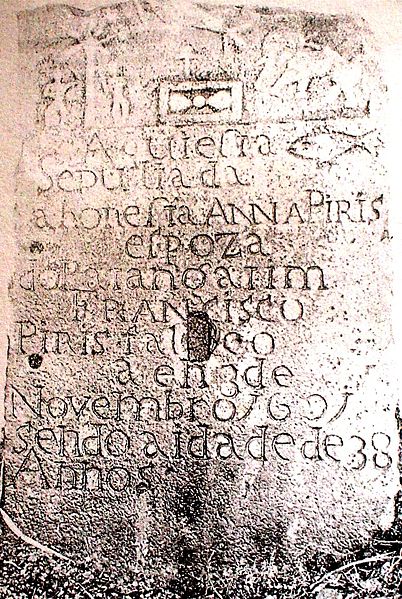
Below: An Elephant and Fish coin from the Anuradhapura period. Compare with Karava tomb stone above to appreciate the long Sri Lankan royal tradition of grouping these symbols together.

The Makara
The Makara, the mythical composite creature and prominent symbol of the Karavas, was also a royal symbol of Sri Lanka's past. The Makara is displayed prominently in ancient royal architecture, on the entrance balustrades of ancient capitals of Sri Lanka. The Makara was also used in ancient Sri Lankan honour arches and door handles in royal palaces and temples and also on sword handles . See 'the Makara' for more.
The Tree
Tree symbolism too appears to have been important in ancient times. The coin from the ancient Anuradhapura kingdom displays such tree symbolism. Such coins have been found in large numbers in the ancient kingdoms of Anuradhapura and Ruhuna
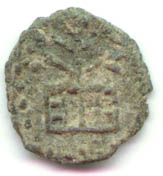
Many kings and Karava clans of Sri Lanka have claimed descent from the princes who came with the sacred Bodhi Tree (See Migration with Bodhi tree) . The symbolism could be connected.
The Elephant symbol
See the Elephant symbol and some of the Karava caste's flags illustrated below for examples of the use of the elephant symbol in ancient Sri Lanka.
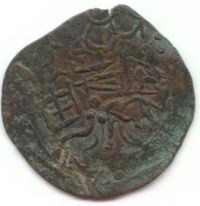
Above: A coin from the ancient Anuradhapura kingdom displaying the Elephant symbol of ancient Sri lankan kings.
The Lion
The Lion was not an important symbol for most Sri Lankan monarchs. They used the lion image on foot-stones at entrances to buildings and on urinal-stones. The lion was an important symbol only for the Indian born Kalinga kings of Sri Lanka, particularly king Nissankamalla (1187-1196 ) who claimed to hail from Sinhapura (lion city). Nissankamalla and other Kalinga monarchs used the lion symbol extensively and popularised it's use during their reigns.
The Karava Singhe dynasty of Jaffna (which succeeded the Kalinga dynasty rulers of Jaffna) has also used the lion symbol as evidenced by the name of the dynasty and the crest of their Karava descendants. Intermarriage with the Kalinga royal families could explain the transfer of their symbolism to the Karavas and explain the existence of ancient Karava Lion flags in Sri Lanka. (see illustrations of ancient Karava Lion flags)
The lion was also the symbol of the south Indian Pallava kings. Pallava coins with the Pallava lion emblem are found in Sri Lanka too and these coins are knowingly or unknowingly mistaken by some as Sinhalese lion coins.
See Lion Myth for more
Karava symbols
Above: The ancestral flag of the Karava Arasakularatne clan from Maggona bearing the Sun, Moon, Tree, Ship and Elephant symbols. Click image to zoom
Above: The ancestral flag of the Karava Mihindukulasuriya clan from Chilaw bearing the Sun, Moon, Fish, Ship and Elephant symbols. Click image to zoom
Above: The ancestral White Elephant flag of the Karavas bearing the Sun, Moon, Fish, Ship and Elephant symbols. Click image to zoom
References
- Ariyapala M. B. 1968 Society in Mediaeval Ceylon Department of Cultural Affairs Sri Lanka
- Bopearachchi Osmund 1999 Ruhuna, An ancient civilisation re-visited
- JRASCB - The Journal of The Royal Asiatic Society (Ceylon Branch)
- Paranavithana S. 1970 Inscriptions of Ceylon Vol I Early Brahmi Inscriptions
- Yatala Vehera 1987 Department of Archaeology Sri Lanka

The Sun, Moon and boat symbols as displayed by medieval Sri lankan kings on their Kahavanu gold coins
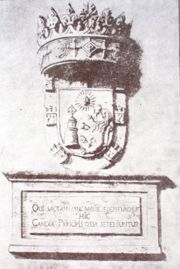
Above: The Sun symbol displayed as the central symbol on the tombstone of Don Joan, Prince of Kandy who was buried in 1642 at the oratory founded by him in Telheeras, Lisbon
.
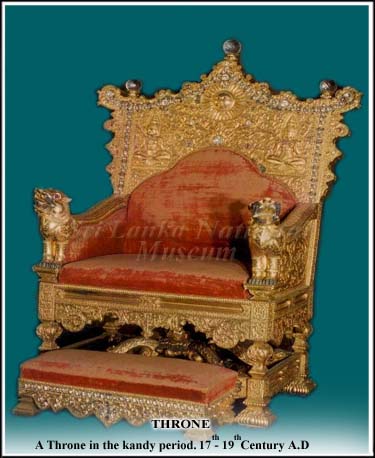
Above: The The Sun symbol displayed as the central symbol on the Kandyan royal throne of Sri Lanka.
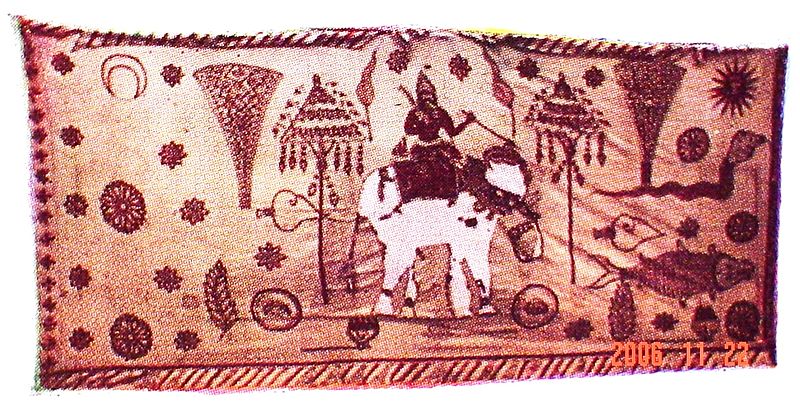
Above: Another ancient flag of the Karava race of Sri Lanka, showing the Mutukuda (royal pearl umbrellas) along with the other royal symbols of the Karavas: Sun & Moon symbols, Sword, White shield, Lamps (torches -pandam), ceremonial shades (alavattam), Yak tail whisks (valviduna) etc. together with Indra, the god of the Kshatriyas.

Right: An old etching of King Rajasinghe and his court. Note the similarity of the royal symbols carried by the courtiers with those on the flag above. Of particular interest are the two pearl umbrellas, the sun and moon symbols, Aalavattam ceremonial sun shades and the white (conch) shield.
Below: an old painting from Sri Lanka showing similar symbols of royalty carried in honour of the king.
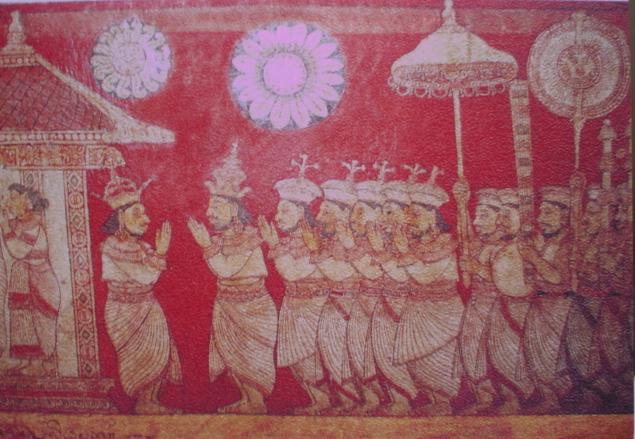

Karava weddings with traditional royal insignia. Above from the early 20th century and below from the late 20th century with the traditional Sun/Moon and royal insignia of the Karava.
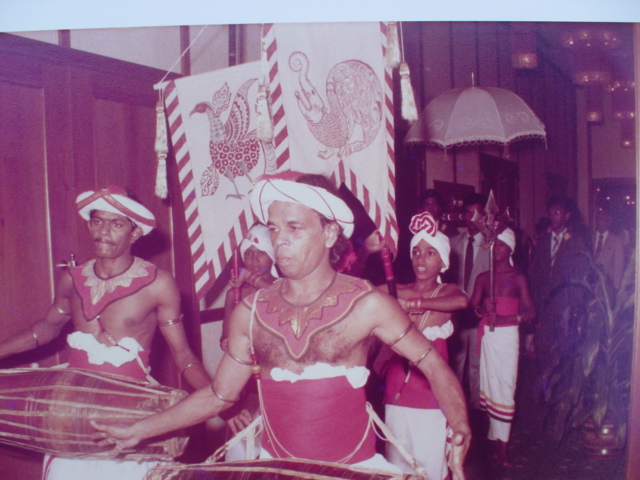
Be they rich or poor, the Karavas are the only community in Sri Lanka that uses royal insignia (Pearl umbrella known as the Mutu kuda, sword, trident, alawattam emblazoned with the sun and moon, sun & moon flag, makara flag, white foot cloths and lighted candles or traditional flame torches) at their funerals. The funeral procession below shows the contemporary adaptation of the Karawa royal insignia in rural Sri Lanka.
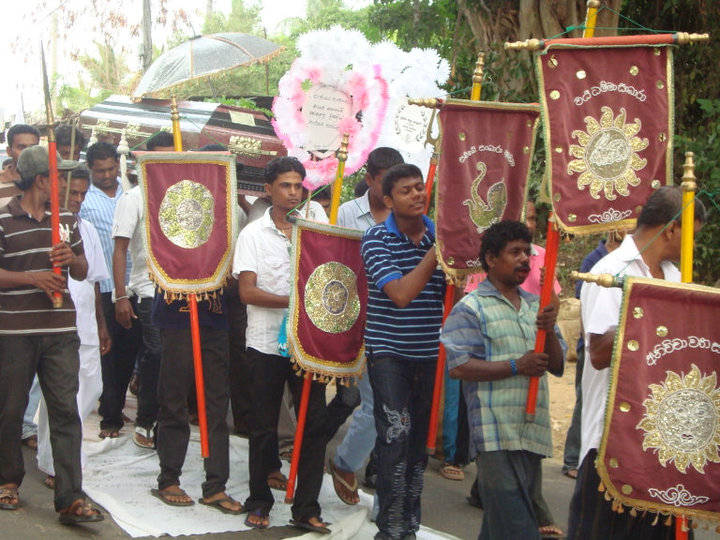
The white umbrella (the Mutukuda pearl umbrella ) was a symbol of royal rank and a vital component of the pancha kakudha bhanda or the five exclusive insignia of royalty . The white umbrella was used by Kings and other royalty including royal army commanders and also used in wars and royal ceremonies. It is usually referred to as Sveta-chatra and sometimes also as Dhavala chatra. The white pearl umbrella ( Mutukuda) has been used by the Kauravas from time immemorial. The Mahabharata relates that they were even taken on to the battle field by the Kauravas. The Kauravas of Sri Lanka use the pearl umbrella to date at funerals, along with other royal insignia such as swords, trident, Sun & Moon flag, Makara flag, whisks, white foot cloths and lamps.
The funeral procession below shows the contemporary adaptation of the Karawa white pearl umbrella (Mutukuda) in rural Sri Lanka.
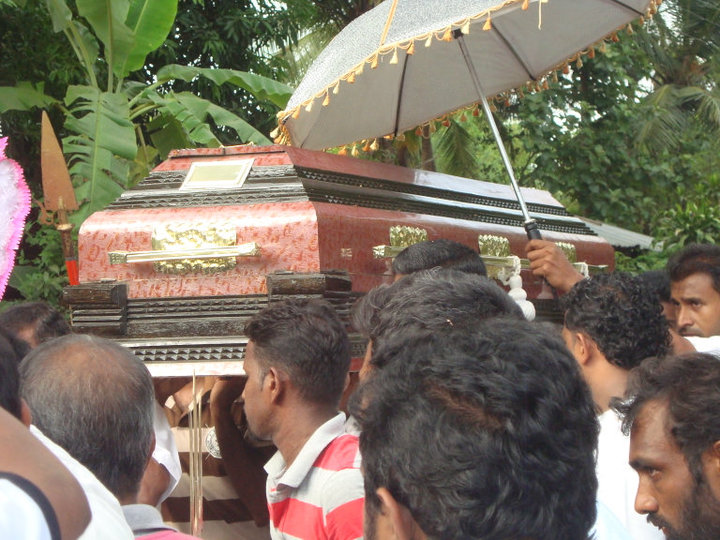
Kshatriya Maha Sabha, Sri Lanka


